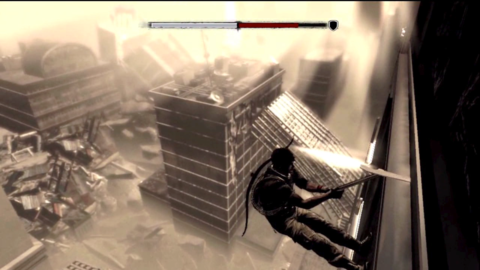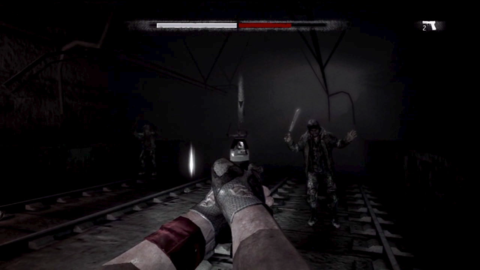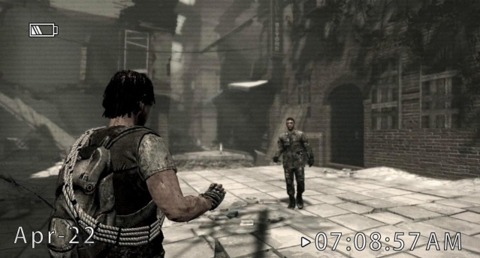
For the first 30 minutes, I Am Alive seems like one of the most refreshing games to come along in years. You're a determined guy who's spent the last year trekking across a ruined America to get back to what's left of your hometown, where you hope your wife and daughter have eked out their survival among the wreckage, or at least managed to evacuate to a safer place. Sifting through the rubble won't be easy. This is a survival horror game without the horror, in which every single bullet is precious and the evil lurks not in hordes of zombies or a shadowy corporation, but within the base hearts of those formerly ordinary people who have traded their humanity for a better chance of staying alive. But there are just as many innocents in the city trying to get by without resorting to killing, and possibly eating, their fellow man.
The game focuses on the mundane exercise of surviving in a modern-day ruin, and makes an implied commitment to extreme realism by limiting your supplies and turning every encounter with other characters into a life-or-death affair--just like it would be, presumably, if the world really did end. In practice, I Am Alive breaks down pretty evenly into fetch quests, rote combat situations, and urban climbing sequences of the Uncharted variety, so it's already more video-gamey than its stark concept would suggest. Still, I was more than willing to stomach a few old-hat design tropes in the hope they would cohere into a unique and memorable experience. In that light, it's a real shame I Am Alive falls so far short of making good on any of its grandiose ideas, almost right from the get-go.
The most successful of I Am Alive's concepts is the focus on health and stamina as finite resources. Health never recharges after you lose it, but you can replenish it with predictably scarce food items. Stamina comes back quickly when you find a place to rest, but your total stamina capacity can drop if you push yourself past the limit in situations of duress. Those include any time you're climbing, or when you descend into the dusty netherworld of the city's street level. That Uncharted style of climbing has been criticized in the past for leading you by the hand with little chance of failure through absurdly dangerous situations, so I love the idea of adding some time pressure to your exploration. But the climbing controls are too awkward and unreliable to consistently get you where you want to go, so you often end up burning more stamina than you ought to. It's tough to comprehend the directions your character will sometimes climb when you're explicitly pushing a different direction on the stick. It's not fun.

That clumsiness extends to the often lethal instances when you're interacting with other human beings. Similar to the way stamina constrains your climbing, I was more than ready to embrace the idea that not every enemy wears his ill intent on his sleeve, and some people aren't exactly friendly but also aren't out to kill you just for the sake of malice. But the game takes such a bald three-tiered approach to presenting NPCs that it's hard not to feel cynical about it after 15 minutes. People are either attack-on-sight bad guys, immobile innocents who want you to fetch them items, or (in rare cases) people who are perfectly happy to let you pass by, as long as you don't pass too close.
It's the first group you'll spend the most time dealing with, as there are roving gangs all over the city ready to cut your throat just for laughs. Again, your methods of dealing with these guys break down into a tidy little list that includes shooting them, getting into a button-mashing "struggle kill" with your knife, kicking them into a fire or off a ledge, or performing a surprise throat-slash of your own if you let them approach you without attacking them yourself. It's that ability to threaten enemies that initially makes the combat seem interesting; if you don't pull your own weapon, enemies will saunter up to you, letting you get in that one crucial surprise kill without wasting one of your precious bullets... which you're not ever likely to have more than three or four of at a time. Once you do aim your gun (when the game switches to first-person), enemies with melee weapons will stop their advance, and you can even demand that they back away from you, which is handy for maneuvering them toward the nearest pit or fire.
The list of problems I ran into with the combat is a mile long. The biggest problem is that the special kill moves (and even the ability to threaten enemies back) all use the same button, and you're at the mercy of the game to provide you the right prompt to pull them off. But it's ridiculous how picky it is about where you and the enemy are standing, and how often it gives you the wrong prompt, or doesn't give you one at all. You might have a guy lined up with a fire expecting to kick him in, but instead you get the "struggle kill" prompt, which locks you into a button-mashing animation, and if there are other enemies around, they'll run up and cut you to death while you're trying to mash your way out of being totally defenseless.

I could give example after example. Armed enemies are always supposed to drop a bullet, but sometimes don't. Occasionally they dropped their guns on the level geometry in a way that prevented me from picking them up. Later on you get a bow and a single arrow, which is meant to be reusable, but the arrow disappeared several times after I used it, forcing me to restart to a checkpoint. Your retries are as finite as your health and stamina items, so it's inexcusable that you have to waste them so often just to make up for the game's basic mechanical failings. And don't even think about rolling back to a previous chapter via the ordinary-looking chapter select menu. When I did that, the game erased all of my progress past the chapter I picked, making me play through it all again.
All that wonkiness might be worth putting up with if I Am Alive made good on what initially looks like a highly personal story of struggle and hope, but it doesn't even do that. The game frames the tale with occasional shots of a camcorder on a table, showing sequences of your quest recorded by your character himself, but that device is never used for anything meaningful. Worse, you abandon the search for your wife and daughter after about 20 minutes, spending the rest of the game acting as an errand boy for other characters you meet with almost no reference to the primary, personal reason you're here in the first place. Then the game culminates in one of the hastiest, most ramshackle endings I've seen in ages, resolving almost nothing and leaving at least one major character pretty much totally unaccounted for.
I Am Alive is extra disappointing because it has so much potential right up front, and then wastes no time squandering all of it. Its premise is exciting but its promise goes wholly unfulfilled, and at some point you've got to stop lauding a game's good ideas and think about how much you actually enjoyed playing it.